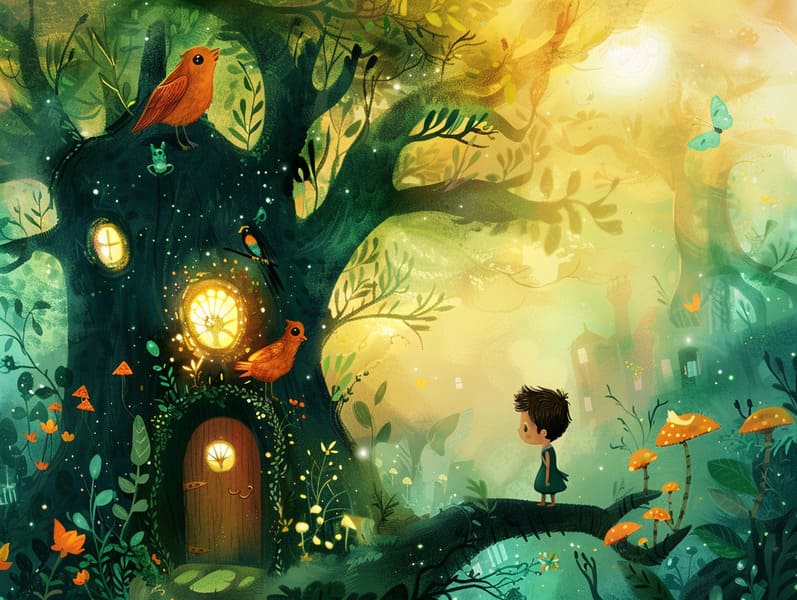
Short fairy tales have old origins. These tales have been conveyed from one generation to the next centuries before they were ever documented. They arose from a variety of backgrounds, including African traditions. They were initially shared among adults, often carrying themes and messages aligned with the societal norms and beliefs of the time.
The famous Grimm duo, Jacob and Wilhelm, were among the first to gather many of these beloved stories. Their volume, "Grimm's Fables," included classics like "Cinder Maid," "Hansel and Gretel," and "Little Snow White," which have since become pillars in the world of famous fairy tales. Similarly, the Danish author's fantastical fairy tales, such as "The Mermaid," and "The Duckling that Could," have won hearts worldwide, ensuring their place in the pantheon of beloved fairy tales.
Despite being ancient, these tales remain as significant as ever, especially as bedtime stories for kids. These fantastical tales are now available in different formats, including beautifully illustrated books, whimsical animations, and online storybooks.
Their continued relevance can be connected to several charming aspects:
Crucial Morals: Timeless fairy tales often teach important moral lessons. Narratives like "The Boy Who Cried Wolf" teach the importance of honesty, while "The Tortoise and the Hare" show the values of determination and humility. These stories offer kids clear distinctions between moral and immoral, helping to shape their moral compass in a mild yet deep way.
Compassion and Knowledge: Classic fairy tales frequently involve characters facing challenges and struggles, urging readers to relate with their struggles and back their triumphs. For instance, "Beauty's Beast" demonstrates the importance of appreciating inner worth to know the inner self of a person, cultivating compassion and knowledge.
Cultural Awareness: Many old fairy tales are rooted in the cultural contexts from which they were born. Reading these tales can provide captivating looks into different social structures, enhancing a sense of cultural insight and recognition.
Inventiveness and Fantasy: The imaginative elements in classic fairy tales—talking animals—awaken children’s dreaming abilities. These stories bring readers to imaginary realms, awakening fantasy dreams and a sense of mystery that persists a lifetime.
Old fairy tales are not only spellbinding but also instructive. They function as magical tools in fostering various mental and emotional abilities in young ones. When ancient fairy tales are read aloud, they strengthen speaking abilities by teaching new words and complicated sentence structures. This practice also enhances hearing abilities and concentration, as young ones stay focused, ready to see what happens next.
Furthermore, debating the themes and characters of timeless fairy tales can improve thinking skills and reasoning skills. Little ones are led to notice patterns, anticipate outcomes, and figure out cause and effect. These conversations also assist little ones utter their thoughts and feelings, boosting their emotional intelligence.
In today’s technological era, the presence of digital storybooks has made these narratives more within reach than ever. Web-based platforms and applications offer ample collections of Grimm's fairy tales that can be viewed or listened to anytime, anywhere. Fairy tales recited are particularly well-liked, giving an interactive way for kids to savor these fantastical tales. Audio stories and voiced videos lead characters and here settings to life, often complemented by enchanting melodies and instrumentals that boost the narrative journey.
The everlasting appeal of classic fairy tales lies in their ability to shift to present eras while keeping their central messages. Contemporary adaptations of these narratives often incorporate more inclusive figures and modern settings, making them familiar to today’s audience. However, the fundamental themes of gallantry, benevolence, and impartiality remain unchanged, continuing to touch kids of all ages.
Timeless fairy tales also offer a sense of security and closeness. They confer upon a coherent narrative with a clear beginning, middle, and end, often ending with the termination of conflicts and the triumph of right over wrong. This uniformity can be encouraging for children, imparting a sense of security in an constantly changing world.
Traditional fairy tales continue to mesmerize and train new generations, maintaining their allure and significance in modern society. As children's bedtime stories, they feature a perfect blend of wonder and wisdom, cultivating moral values, empathy, and creativity. The proliferation of web-based fairy tales and the favor of fairy tales narrated affirm that these timeless tales remain accessible to new generations.
By keeping and narrating these fairy tales, we continue to laud the rich tapestry of tales and cultural heritage. Whether you are accessing a colorful picture book, delving into a virtual library, or playing an narrated book, the splendor of traditional fairy tales is always within reach. These tales demonstrate of the timeless influence of narratives and its ability to draw us together across epochs and places.
Whether you are perusing a gorgeously illustrated book, viewing a web-based collection, or hearing an audiobook, the attraction of traditional fairy tales is always within reach.
These fairy tales demonstrate of the endless force of storytelling and its ability to connect us across centuries and lands, weaving a spell that enchants and educates alike.